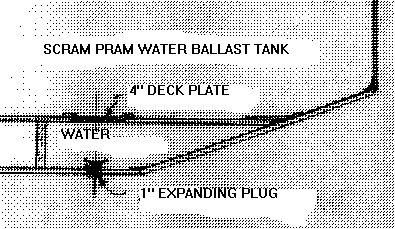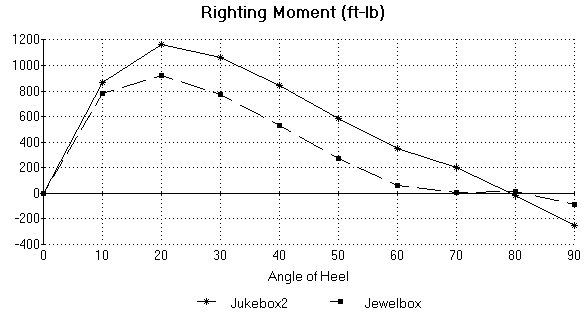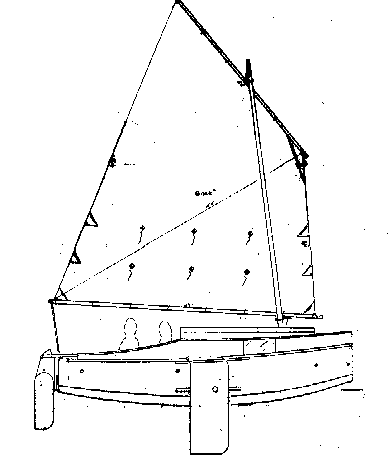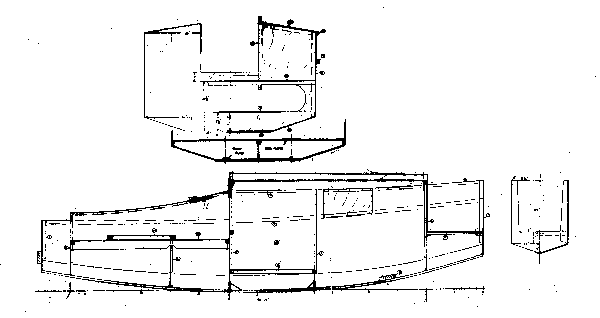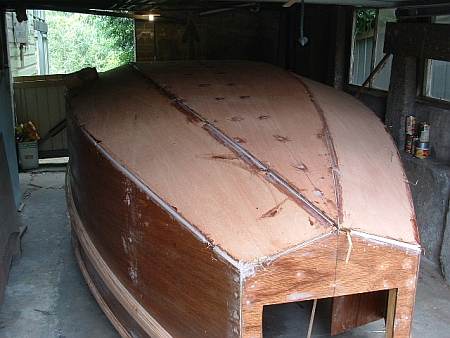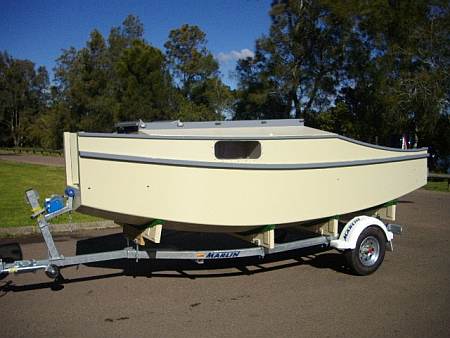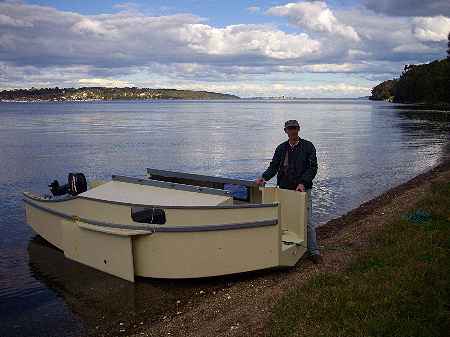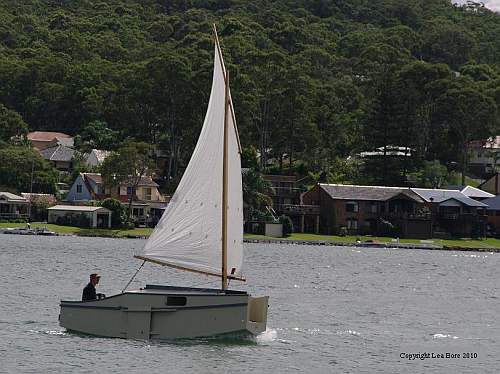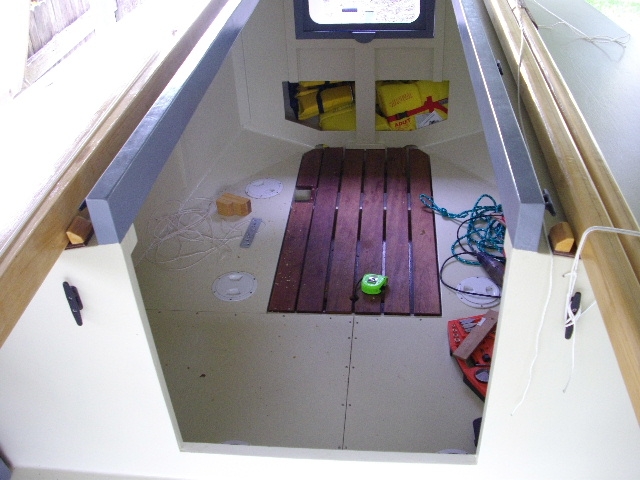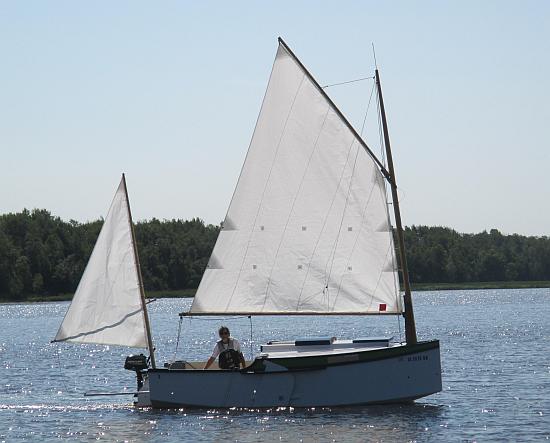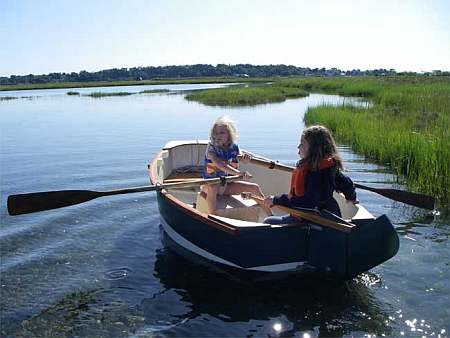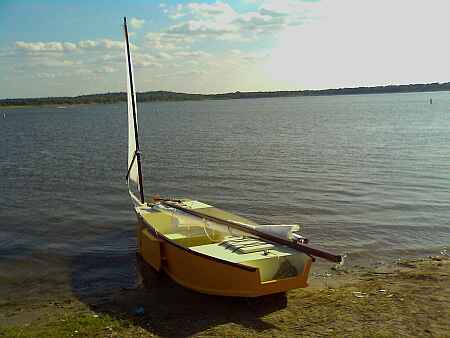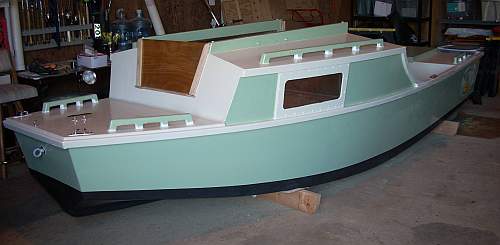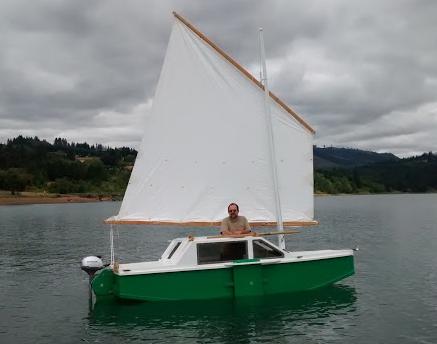Jim Michalak's Boat Designs
1024 Merrill St, Lebanon, IL 62254
A page of boat designs and essays.
(1 May 2020) We look deeper into the mysteries of water ballast. The 15 May issue will discuss mast tabernacles.
THE BOOK IS OUT!
BOATBUILDING FOR BEGINNERS (AND BEYOND)
... is out now, written by me and edited by Garth Battista of Breakaway Books. You might find it at your bookstore. If not check it out at the....
ON LINE CATALOG OF MY PLANS...
...which can now be found at Duckworks Magazine. You order with a shopping cart set up and pay with credit cards or by Paypal. Then Duckworks sends me an email about the order and then I send the plans right from me to you.
REND LAKE 2020...CANCELLED!!
..I see no way that any gathering will be safe by mid June, at least not in southern Illinois where the virus is still gathering steam. Campgrounds are still closed, no word on reopening, and some launch ramps also. First miss in over 30 years, but we will be back next year.
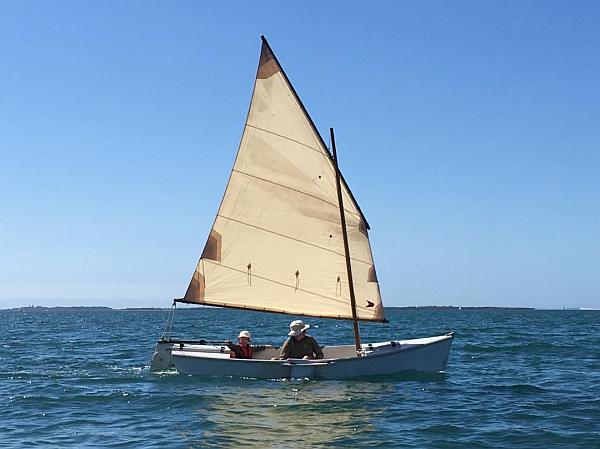 | Left:
Ross Lillistone built this Mayfly about ten years ago in Australia. He writes, "Me being skippered by my five year-old grandson. He has been in sailing dinghies since he was six months old....longitudinal trim is so important, and she is sailing beautifully in these conditions." |
|
Water Ballast Details
WATER BALLAST DETAILS...
SO you've decided to try water ballast. How to do the ballast box? How to flood and drain it? The only boat I've designed with water ballast (so far) was Scram Pram. There were two Scam prototypes built and the first one had the water ballast and second didn't. Here is a letter from the first builder......
.........My sage and good friend, Tim Webber, keeps sending me articles on water ballasting from his homesite. I built a waterballasted boat called Ghostling(design is listed as Scram Pram on Jim Michalak's page).
Of the articles I read I have no real substance of disagreement. However, my experiences with Scram Pram may add these different observations.
First, it is highly impractical to be shifting water ballast from one side to the other unless the boat is: 1) large and 2)on long tacks. Even given these requirements it is still a risky business to make an emergency maneuver with this profile. Before I leave this subject, I would like to point out that of the articles I read I did not find a mention of stress loading on the rigging caused by loading one side and making the other bouyant. Having collapsed two mast supports on previous crafts, this is a phenomenon that I've had some time to contemplate.
Next I want to approach the recurrent subject of water ballast taking up too much space in the craft. If one is going to water ballast they should choose a boat with not only the right shape, mainly wide and fairly flat bottom, but also a design that could integrate the tanks into the structure. For example, Scram Pram easily takes on 300 lbs of water ballast and it actually improves the interior of the boat by adding a strong internal keel, comfortable seats/beds, and providing foot rests. In this case the tanks were in the design from its' inception and of course, Scram Pram is 100% waterballasted. Also, she moves exceedingly well in light air whether ballasted or not.
On Scram Pram I devised a 3 tank system(the third tank being Jim Michalak's idea to be used as a trim tank). Scram had two saddle tanks forming the beds, seats, foot rests and internal keels.
The two saddle taks accounted for about 250 lbs. of the water and each one had 3 apertures in it. 1) first there was the obvious hole in the bottom at the deepest point of 1/2 inch and it filled it like a water fountain. 2) Next was a port hole directly over it with a see-through cover just large enough to put you hand through to put in a stopper if you cared to. This was not necessarry since the tanks were capable of holding their fluids by sheer force of vacuum. 3) The third apeture was at the front of the tank and had a PVC pipe of 3/4 in. rising a foot or more with a screw-on cap with petroleum jelly kept on it as well as the screw-down port cover to prevent air leakage; remember, a tight seal is necessary if we are going to create a vacuum.
This arangement fills and empties quickly giving one the option of using no ballast at all on those light days when you have a number of passengers that you can shift from side to side catamaran-style and the see-through port allows you to check the status of your tanks to see if they are loosing their water and if your vacuum is working properly.
One thing I did not test with Scram Pram that should work is the addition of a bicycle valve at the top of the PVC cap. This simple addition would allow one while under way to "blow" the tanks submarine style when the wind dropped, you picked up more gear, or for those suicide jockies, just to blow the leeward tank to gain more upright sail area at the cost of some stability on the boat.
The air used to empty the tank could come from a compressed can, an electric pump or a manual foot pump. The last two options are certainly inexpensive enough.........
Thanks, -
I've never seen the installation mentioned above, but the Scram tanks look like this:
My idea at the time was to fill the tank by removing the deck plate, reaching into the tank and pulling the drain plug. Then stand by as it fills to replace the plug just as the tank is full. If the top of the tank is above the normal waterline, the tank may not fill all the way and you have to top it off with a bucket and replace the deck plate. If the tank top is below the waterline and you forget to replace the plug, your boat could sink. Anyway, I think he system would work with very cheap stuff and no external plugs to deal with. (I'm not sure how Bolger did it on Martha Jane?)
What the Texas Scram builder did was the above but he added a standing pipe with something like an airtight valve on the top, as I understand it. So he can fill the tank by opening the bottom port and let the water rush in while the air rushes out of the open tube. When full (assuming the tank top is below the waterline) the tube is sealed and the water somewhat trapped in the tank. It's very much worth a try and is a noble experiment in that it is cheap, and that if it works is an improvement, and if it doesn't work it can be returned to the original design very easily.
I don't know how much testing the Texas Scram got, but one thing I would watch out for with the tube system: On a long, long tack with lots of heel, the up side tank may not hold its water by vacuum alone. It may dribble out slowly. Solution would be to just use the plug. But for a fin keel water ballast system designed merely to right the boat in a knockdown, wouldn't this system be perfect?
EFFECTS ON A REAL DESIGN....
Last issue we used the Hullform6S program to look at stability of a simple rectangular "boat". Let's look at a real design. The example here will be Jukebox2. And we'll put in some spice by comparing the results with Jewelbox, a very similar boat that used the unballasted Birdwatcher cabin system.
Here are some rough cuts at the weights and CG's:
Jukbox2: Item .Weight(W) .Height above bottom (X) .WX Hull 700 21 14700 Bottom 100
4 400 Mast 50 100 5000 Yard 12 210 2520 Sail 5 150 750 Boom 16 70 1120 Crew 200 36 7200 Ballast 300 3 600 Totals 1380 23.4" 32300
Jewelbox: Hull 700 21 14700 Bottom 100 4 400 Mast 50 100 5000 Yard 12 210 2520 Sail 5 150 750 Boom 16 70 1120 Crew 200 18 3600 Total 1080 25.9" 28090
Running the above weights and CG's through Hullforms and I get the following righting moment curves:
....COMMENTS...
Both boats have the same basic length, cross section in the cabin, and bottom shape. They have identical sail rigs. In the weights you will see the item "bottom". Both boats have a thick 1" bottom and this separate item is supposed to account for the extra weight there. As for the crew situation, it changes all the time, of course, but the crew on Jukebox is above the overall CG and adding more crew makes it less stable. For Jewelbox the opposite is true. Adding more crew to Jewelbox makes her more stable since the crew sits below the overall CG. Also, in the analysis of Jukebox, only the watertight volumes of the hull were used in the Hullforms file. If you look at the gif of Jukebox below, Craig O'Donnell has presented one that shows the watertight volumes. For the Jewelbox, all the volume is watertight except for the small bow well.
...JUKEBOX2...
I had hoped this boat would be self right up to 90 degrees but it looks like it goes to 80 degrees in this ballast situation. (What does that mean? Chapelle considered righting from 45 degrees of heel was fine for a sharpie while today's bluewater sailors like to self right quickly from 140 degrees of roll.) I think another 100 or 200 pounds of ballast is needed to get it to 90 degrees. Although this discussion is about water ballast, any ballast material of the same weight mounted inside the hull at the same location will have the same effect. (The Jukebox2 plans show the ballast as steel bars bolted across the bottoms of the bulkheads.)
I didn't have a chance to show a "no ballast" situation for Jukebox but the numbers show that removing the 300 pounds of ballast reduces the weight by 300 pounds and raises the CG almost 6". Maximum righting moment goes from 1170 ft -lbs with 300 pounds of ballast to 820 ft-lbs with no ballast (both at 20 degrees heel). Worse yet, the unballasted boat will capsize at 50 degrees of heel. So here the ballast seems well worth it.
I might add that the 300 pounds of ballast, if done with water, would be about 5 cubic feet. This boat is 5' wide on the bottom so the ballast tank might take the form of a full 5' width box, 6" high and 2' long.
...JEWELBOX... I think the fact that the Jewelbox righting moments are generally less than Jukebox's in the usual sailing range is mostly because she is about 30% lighter. If she were loaded with two more people and brought up to a weight about equal to Jukebox's I'd think she might be even stiffer than Jukebox. But the most valid comparison might be with the unballasted Jukebox which weighs the same as the Jewelbox. The advantage of the Jewelbox is that it won't flood and maintains a small righting moment past 80 degrees of heel.
Blobster
BLOBSTER, SAILBOAT, 16' X 6.5', 750 POUNDS EMPTY
Blobster has a lot of features I like in a boat. Lots of volume for its size, sort of like Micro or Scram Pram. The multichine shape is almost exactly like Scram's but this one does not have a Birdwatcher cabin. It has the more traditional cabin with a raised watertight deck behind. Also it has one feature I would love to have in my personal boats - a step-through bow so that when you beach you can go forward through the cabin and out the front without going into the water or climbing over the bow. The cabin also has a slot top roof.
This shape of boat with multichines has proven good in rough water and with fair speed in spite of its blobular proportions. Blobster has about 600 pounds of water ballast in its belly and should be OK to 90 degrees heel although such depends mostly on weight distribution of the crew, something the designer has little control over. On the other hand, if the crew jumps overboard the boat will be almost assured of righting without their help. Then the problem becomes reboarding. Be prepared!
Sail rig is a large but simple 139 square foot balanced lug on an 18' mast. Mast is stepped off center to allow you to walk upright down the slot top and out the front. Should be rigged in an instant with no one going on deck ever. All very low tech built with common materials but effective.
The prototype Blobster was built by Miles Bore in Australia. He had built several boats prior, including a Micro, and did a great job of it using very nice materials.
Outside and on its trailer for the first time, the likeness to Micro is clear. But you can see it was meant to be much easier to trailer and launch.
Then he used it for a while as a low power motor cruiser while he finished the sail rig. You can see how easy the boat was meant to use from the beach with its step through bow transom.
Then for the rig and off for a sail, shown here with ballast tanks full. Miles reports it sails with no vices so far. No, he hasn't capsized it yet.
Miles got this photo of the inside. The living platform you see is 7' long and 6' wide max and about 42" at its deepest from platform to slot top. With the slot top cabin and step through transom it is a pretty airy home. Maybe not the little cruiser that Micro is but clearly much easier to use in general and a good choice for a daysail when you have but a couple of hours at the lake.
Great job, Miles!
Blobster uses taped seam construction. Five sheets of 1/4" plywood, eleven sheets of 3/8" plywood and one sheet of 1/2" plywood.
Plans for Blobster are $45.
Prototype News
Some of you may know that in addition to the one buck catalog which now contains 20 "done" boats, I offer another catalog of 20 unbuilt prototypes. The buck catalog has on its last page a list and brief description of the boats currently in the Catalog of Prototypes. That catalog also contains some articles that I wrote for Messing About In Boats and Boatbuilder magazines. The Catalog of Prototypes costs $3. The both together amount to 50 pages for $4, an offer you may have seen in Woodenboat ads. Payment must be in US funds. The banks here won't accept anything else. (I've got a little stash of foreign currency that I can admire but not spend.) I'm way too small for credit cards.
We have a Picara finished by Ken Giles, past Mayfly16 master, and into its trials. The hull was built by Vincent Lavender in Massachusetts. There have been other Picaras finished in the past but I never got a sailing report for them...
And the Vole in New York is Garth Battista's of www.breakawaybooks.com, printer of my book and Max's old outboard book and many other fine sports books. Beautiful job! Garth is using a small lug rig for sail, not the sharpie sprit sail shown on the plans, so I will continue to carry the design as a prototype boat. But he has used it extensively on his Bahamas trip towed behind his Cormorant. Sort of like having a compact car towed behind an RV.
And a Deansbox seen in Texas:
Another prototype Twister is well along:
A brave soul has started a Robbsboat. He has a builder's blog at http://tomsrobbsboat.blogspot.com. (OOPS! He found a mistake in the side bevels of bulkhead5, says 20 degrees but should be 10 degrees.) This boat has been sailed and is being tested. He has found the sail area a bit much for his area and is putting in serious reef points.
AN INDEX OF PAST ISSUES
THE WAY BACK ISSUES RETURN!
MANY THANKS TO CANADIAN READER GAETAN JETTE WHO NOT ONLY SAVED THEM FROM THE 1997 BEGINNING BUT ALSO PUT TOGETHER AN EXCELLENT INDEX PAGE TO SORT THEM OUT....
THE WAY BACK ISSUES
15may19, Sail Shaping 2, Laguna
1jun19, Capsize Lessons, QT Skiff
15jun19, Rend Lake 2019, Mixer
1jul19, Scarfing Lumber, Vireo14
15jul19, Rigging Lugsails, Vamp
1aug19, Rigging Sharpie Spritsails, Oracle
15aug19, Rowing1, Cormorant
1sep19, Rowing2, OliveOyl
15sep19, BC Scram Pram, Philsboat
1oct19, Herb's OliveOyl, Larsboat
15oct19, Herb's OliveOyl 2, Jonsboat
1nov19, Herb's OliveOyl 3, Shanteuse
15nov19, Herb's OliveOyl 4, Piccup
1dec19, Taped Seams, Ladybug
15dec19, Plywood Butt Joints, Sportdory
1jan20, Sail Area Math, Normsboat
15jan20, Trailering, Robote
1feb20, Bulkhead Bevels, Toto
15feb20, Cartopping, IMB
1mar20, Small Boat Rudders, AF4Breve
15mar20, Rudder Sink Weights, Scram Pram
Table of Contents
